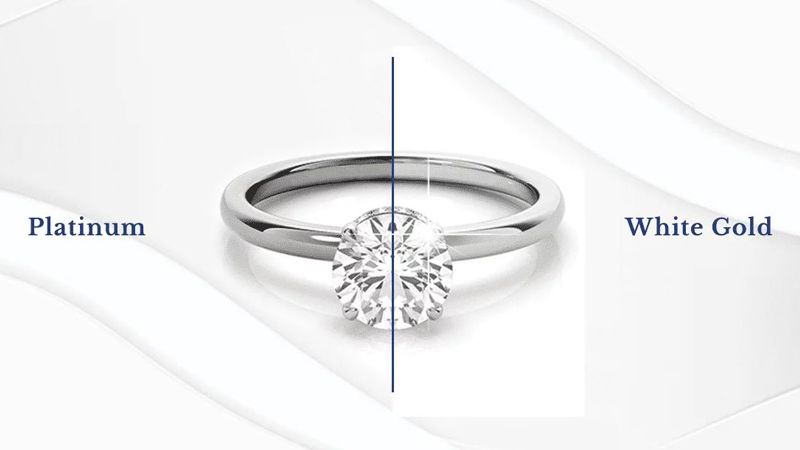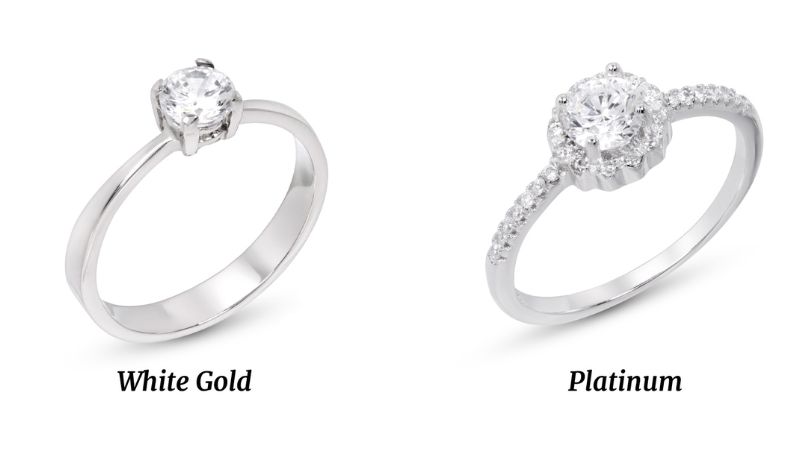Blog Replica Watches
The Difference Between White Gold and Platinum in Jewelry
Many people often confuse white gold and platinum due to their similar appearance and widespread use in crafting high-end jewelry. However, these are two entirely different materials, with differences in value, color, hardness, and durability. Let’s explore the distinctions between white gold and platinum through the following article with DWatch Global!
The Difference Between White Gold And Platinum
What is Platinum?
Platinum jewelry is made from platinum, a precious metal naturally occurring in a white color, resistant to oxidation, corrosion, and even high temperatures, with a high hardness of up to 4.5 Mohs. The name “Platinum” originates from the term “Platina Del Pinto” in Spanish, meaning “silver-white of the Pinto River.” Platinum is often found in some nickel and copper ores, with 80% of production coming from South Africa. Platinum jewelry typically contains high-purity platinum ranging from 950/1000 to 999/1000, indicated by PT950, PT999.

What is White Gold?
On the other hand, white gold jewelry is a type of alloy made with gold combined with other metals such as palladium, nickel, and coated with Rhodium to achieve its characteristic white color, with a maximum hardness of only 3 Mohs. The specific properties of white gold vary depending on the alloy accompanying the gold. Gold alloyed with nickel will be harder and more durable, suitable for crafting engagement rings…
Additionally, gold-palladium alloys are softer, more malleable, suitable for intricately set gemstone jewelry. White gold used in jewelry is typically 18k gold or 14k gold, denoted respectively as AU750 or AU610.
Comparing The Value Of White Gold And Platinum
The Price Difference Between White Gold and Platinum
One significant difference between white gold and platinum is their price, with platinum jewelry often being more expensive than white gold.
Platinum is 40% heavier than 18k gold, meaning jewelry made of platinum will be heavier than those made of white gold of the same size. This leads to a higher cost. Another reason for platinum’s higher price is its rarity, as this metal is found only in certain locations worldwide. Furthermore, platinum used in jewelry requires a higher purity than gold. While white gold jewelry typically has a purity of under 75% (18k), platinum must have at least 90% purity to be considered platinum jewelry.
Differences in Color Between White Gold and Platinum
While white gold and platinum may look similar in color, there are some differences in their appearance, especially over time.
While platinum is a naturally white metal, white gold is an alloy of gold, other metals, and Rhodium plating to achieve its silver-white color.
It’s essential to note that the Rhodium plating will wear off over time, revealing the original yellowish-gold color. This is why to maintain the brightness and whiteness of white gold, you’ll need to re-plate it with Rhodium after some use.

On the other hand, platinum does not change color or fade, but it can scratch and develop a patina that can make it look dull over time. If you want to restore the brilliance of a platinum ring, it will need to be polished.
Differences in Durability Between White Gold and Platinum
So, what is the difference in durability between white gold and platinum? Platinum’s advantages include resistance to oxidation, high corrosion resistance, and the ability to withstand temperatures of up to about 1800°C. In comparison, when considering white gold vs. platinum, white gold can withstand lower temperatures, only around 1000°C. Therefore, jewelry crafted from platinum is less likely to warp or deform over time compared to white gold.
Differences in Popularity Between White Gold and Platinum
Considering the difference in popularity between white gold and platinum, white gold is more affordable and easier to work with, making it more popular than platinum. However, with the advantages in color durability and hardness between white gold and platinum, platinum is undoubtedly capturing the hearts of more jewelry enthusiasts. In the world of diamond rings, platinum rings are considered superior to white gold rings when combined perfectly with diamonds.
Differences in White Gold and Platinum Jewelry Rings
Speaking of white gold and platinum, platinum has high corrosion resistance and high density, making it more labor-intensive to craft than white gold. Therefore, to design a sharp, platinum ring, the jeweler must be skilled, meticulous, and highly skilled.
Meanwhile, white gold is soft, with a low melting point and easy to bend, making crafting a detailed, sharp white gold ring easier and less labor-intensive than platinum. As a result, white gold jewelry pieces often have a more comfortable price and higher detail than platinum rings.

Understanding the differences between white gold and platinum is crucial when choosing your jewelry pieces. Whether it’s the elegance and rarity of platinum or the affordability and versatility of white gold, each has its unique appeal in the world of fine jewelry.

